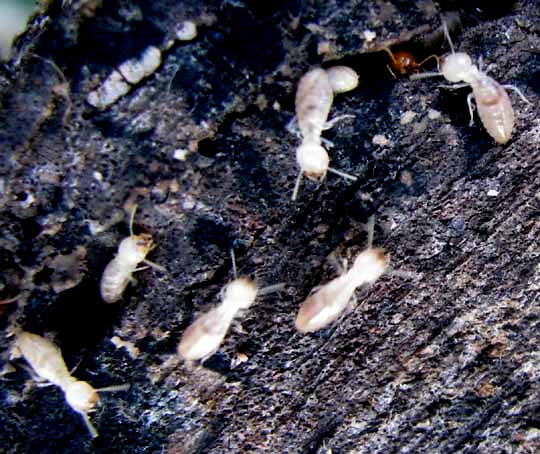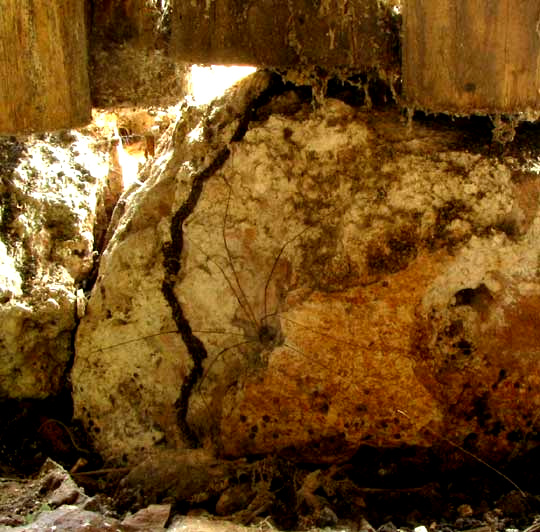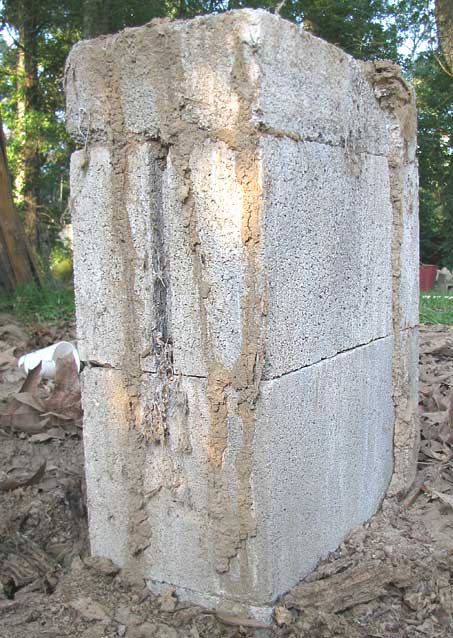Excerpts from Jim Conrad's
Naturalist Newsletter
from the January 1, 2012 Newsletter issued from Hacienda Chichen Resort beside Chichén Itzá Ruins, central Yucatán, México
TERMITES
The outside shower is surrounded on three sides by walls of lashed together, vertical poles cut from the nearby forest. After showering I drape my washrag atop the pole wall to dry. The other morning when I retrieved the washrag for bathing, it came away encrusted with ant-size, ant-shaped, white, scurrying-about insects. Atop a pole where the washrag had lain overnight, dozens of the same ghostly insects emerged from tunnels inside the pole and tumbled over the wall's sides. A few of them can be seen at that moment below:

Of course despite their anty appearance they were termites, and it's apparent that for a long time they've slowly been eating the shower's wall poles as they tunneled through them. In the picture the white-headed ones are workers while the amber-headed one peeping from a crack is a soldier. You know that these are not some kind of white, wood-burrowing ant because of their thick bodies. Ant bodies have hair-wide constrictions between their three main body sections, but termites display only a modest narrowing behind their heads.
This got me to wondering whether the poles forming the walls of the hut I live in similarly are slowly being devoured by termites. I had reason to think that maybe they weren't because when the poles had been tied together they'd been set with their bottom ends atop limestone rocks precisely to keep the poles' ends off the ground. Once I started looking inside the hut, however, I found several instances of what's shown below:

That picture shows several wall-poles atop a white limestone rock upon which not only a little dust and a spraddly-legged harvestman or daddy-longlegs have settled, but also there's a dark, slender tube snaking from the ground, up the rock's face, to the bottom of a pole. That tube is a termite shelter tube much like the ones seen ascending big tree trunks here, connecting large termite nests built on the trees' limbs with the ground.
Termites need to stay moist to survive, plus they're relatively weak and fragile insects vulnerable to ants and other predators when exposed. Shelter tubes, which generally are made of termite feces, plant matter, saliva and soil, maintain a termite-congenial humidity inside the tubes, and hide the termites from their enemies. There's even a shelter tube running across the tile beneath a leg of the table on which I'm typing this, and then up the table's leg, ending where the leg and tabletop meet.
Well, about 4000 termite species are estimated to exist, and they're particularly common in the tropics where their recycling of wood and other plant matter is of major ecological importance to every local ecosphere, so this is no big surprise.
I'm just glad that that morning I'd glanced at my washrag before soaping it up and scrubbing my armpits.
from the June 16, 2008 Newsletter, issued from the forest near Natchez, Mississippi; elevation ~400ft (120m), ~N31.47°, ~W91.29°:
TERMITE MUD TUBES
This week I've helped Karen and Jacky tear down an old building that for a long time has been falling down all by itself. One reason for its decay was that it had termites.
You might remember from my Yucatan days that often down there we ran into large termite nests suspended in trees. In the US, because of cold winters, nearly all termite species live in the soil. When our termites burrow through wood in buildings, then, they have the problem of traveling between their above-ground meals and their subterranean nests. Of course a plump, juicy termite with no stinger or pincher would make a good meal for many birds and other predators.
Subterranean termites solve that problem by building mud tubes between the ground and their above-ground meals. Workers travel back and forth in the tubes unseen. This week, once the collapsing building was removed, we found many termite tubes climbing up the foundation blocks. You can see some below:

Not only does the tubing protect commuting termite workers, but also fungi grow in the tunnels' moist darkness. These fungi are eaten by the termites, and supply protein and vitamins that may not be present in wood.
You probably know that termites themselves can't digest the wood they eat. In the termites' digestive tracts the wood is converted into soluble nutritive substances by protozoans living there. The termites can't live without the protozoans in their guts, and the protozoans can't live without their termites. And both termites and protozoans benefit from those mud tunnels.
from the May 2, 2004 Newsletter, issued from near Natchez, Mississippi:
A TERMITE BLIZZARD
At the woods' edge suddenly I noticed that the air was sparkling. I'd been looking for mushrooms and just hadn't noticed that around me thousands of small insects with fluttering wings glistening in the sunlight were gathering. It was the biggest swarm of this type I'd ever seen.
The first thing to do when coming upon such a swarm is to figure out whether they are termites or winged ants. This was easy because dozens were entangled in the hairs on my arms and naturally I was carrying my handlens. A quick glance at one, which had just left its wings suspended in my arm hairs and was ticklingly climbing toward my hand, confirmed its termiteness. Winged ants have "wasp waists" -- very narrow constrictions in the middle of their bodies -- and bent antennae, while termites are about the same width their entire length, and their antennae are straight.
What a perfect snowstorm of termites! Green Anoles in the trees ran from one meal to the next hardly paying attention to my presence. Carolina Chickadees continually laughed their nasal calls while darting from branch to branch snatching all they could. A Squirrel Treefrog gave the impression of having eaten so much that his stomach hurt. He curled onto his side making a comma-shape, squinted his eyes and gaped, but when a termite landed right before his nose he lunged at it and swallowed it in a flash. Spiders scrambled about carrying termites mummified in silk cocoons, or squirming in their fangs.
When the termites landed, their wings came off and they ran away looking like black ants. No small number took the chance to mate, so it was normal to see couples stuck together by their rear ends, one pulling the other along. In places the ground was silvery with discarded wings.
After the deluge of termite fallout subsided, a breeze came along making brief whirlwinds of silvery, broken- off termite wings. Spiderwebs, so covered with sparkling wings that they drooped, looked like sequined necklaces.
from the April 20, 2003 Newsletter, issued from near Natchez, Mississippi:
TERMITES SWARMING
I returned to the trailer and sat at the computer writing the above words. When finished, I looked out the screen door and for a moment I thought my outside kitchen was on fire. What I saw was hundreds of winged termites lifting into the air, with sunlight glistening in their fluttering wings.
They were emerging from beneath a pile of firewood in a corner of my kitchen. On the pile a Green Anole (green "chameleon" lizard) was rushing from termite to termite, wings and other termite body parts dangling from his chomping jaws. Members of the lizard family have trouble looking excited, but somehow this lizard gave the clear impression of being overjoyed.
Nor was the Green Anole the only creature benefiting from this outbreak of termites. Inside my kitchen the ground is dry and dusty, perfect for Antlions, or "Doodlebugs," the little insect larvae that make conical pits in dust and sand, lie beneath the pits with their jaws open, and wait for something to slide into their pit. I watched one termite having problems getting airborne wander into the Doodlebug zone. Right according to script he slid into a pit and instantly tiny pincers from below grabbed him around the abdomen and dragged him into the dust, to be sucked dry.